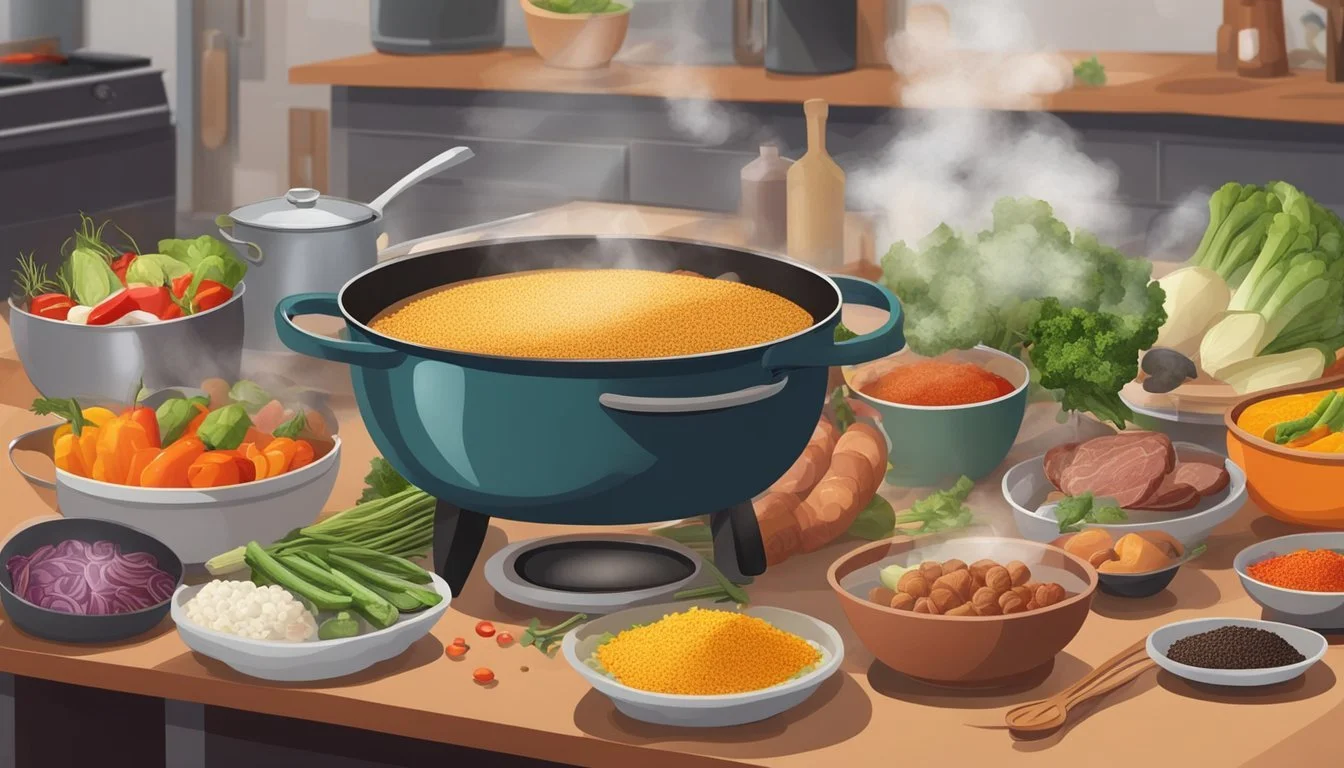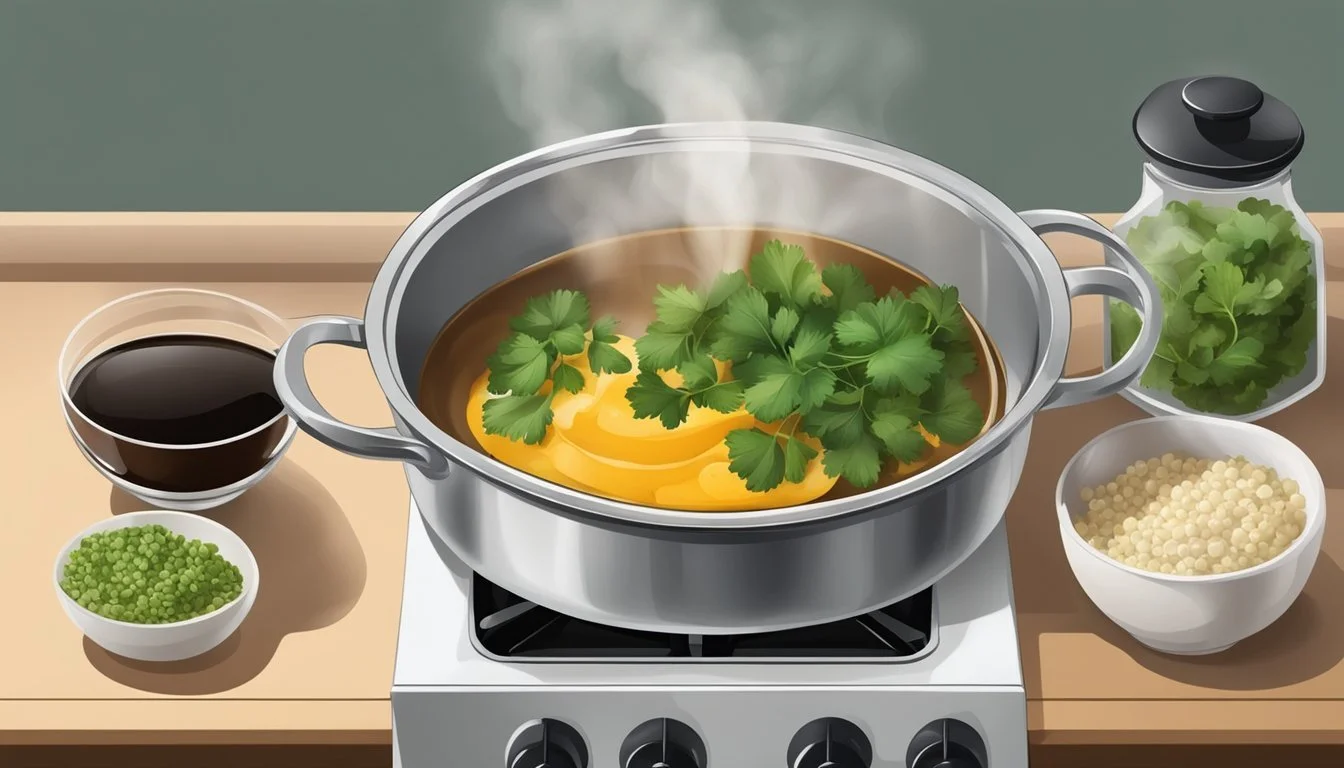How to Cook When You're Experimenting with Fusion Flavors
A Guide to Bold Culinary Adventures
Experimenting with fusion flavors is an inventive culinary journey that marries diverse traditions to create novel eating experiences. It is a culinary domain where cooks embrace the diversity of the world’s pantry, combining ingredients and techniques from different cultures. Such experimentation not only sparks creativity in the kitchen but also results in a symphony of flavors that can redefine what we understand as traditional cuisine. Cooks endeavoring in fusion need to have a firm grasp of the flavor profiles they are working with to ensure a harmonious blend rather than a culinary clash.
The essence of fusion cooking lies in a delicate balance – respecting each culinary tradition while seeking ways to interweave them coherently. It is about understanding the core principles that define various cuisines and thoughtfully pairing elements that enhance one another. This approach results in dishes that are innovative and often, a delightful surprise to the palate. The key to successful experimentation in fusion cuisine is an open mind and a willingness to test new combinations, accepting that not every attempt will yield a masterpiece, but each will be a learning experience.
The driving force behind fusion cuisine is the rich tapestry of global culinary traditions that provide an endless array of flavors, textures, and aromas to play with. As the world becomes ever more interconnected, so do our eating habits, leading to an upsurge in the popularity of fusion dishes. Cooks embarking on this culinary adventure should stay informed about the ingredients and methods they are fusing, ensuring each dish is a respectful and exciting blend rather than a discordant mixture.
Understanding Fusion Cuisine
Fusion cuisine represents the creative intertwining of culinary traditions from multiple cultures, resulting in the birth of novel flavors and dishes that transcend conventional gastronomy.
History and Evolution of Fusion Flavors
The concept of fusion cuisine is not a new one; it has evolved over decades as a result of global trade and cultural exchange. Some sources trace its modern roots back to the 1970s in California, where chefs began intentionally combining elements from different culinary worlds. It's a testament to culinary creativity, reflecting a progressive era where global flavors are as close as the nearest kitchen.
Influential Eras and Locations:
1970s, California: Counterculture movement catalyzes fusion cooking.
Global: Widespread immigration and travel fuel cross-cultural experimentation.
Defining Fusion Flavors
Fusion flavors arise when chefs blend ingredients, techniques, or presentations from two or more cultures. Disparate elements from distinct culinary spheres are combined to create innovative dishes that pay homage to their roots while charting new terrain.
Key Components:
Ingredients: A careful selection from varied traditions.
Techniques: Traditional methods applied to non-traditional recipes.
Presentation: Aesthetic elements from different cultures offer visual appeal.
The experimentation intrinsic to fusion cuisine encourages a rich dialogue between the familiar and the novel, showcasing the limitless potential of global flavors and reinforcing the universality of culinary creativity.
Fundamentals of Flavor Pairing
In the journey of fusion cooking, understanding how flavors combine and contrast is essential to crafting dishes that resonate with bold innovation and respect for culinary traditions.
Complementary Flavors and Contrasting Tastes
Complementary flavors are a pair of flavors that, when combined, enhance each other to create a richer experience than either could alone. Chefs look for combinations where the primary notes of one ingredient uplift the secondary notes of another. For example:
Sweet and Salty: A classic duo where sweetness can highlight saltiness, bringing depth to a dish. A pinch of salt can enhance the inherent sweetness of caramel.
Sour and Spicy: These flavors often coexist in dishes like Tom Yum soup, with the sharpness of lime cutting through and balancing the heat of chili peppers.
On the other hand, contrasting tastes involve components that may seem diametrically opposed but when paired correctly, they can lead to a harmonious and exciting tasting experience:
Sweet and Bitter: The presence of a sweet element can temper the sharpness of a bitter component. Dark chocolate and sweet strawberries are a prime example.
Bitter and Salty: Bitter greens like arugula become more palatable when combined with a salty cheese or dressing.
The Role of Spices and Herbs in Fusion
Spices and herbs serve as the backbone of flavor building in fusion cooking. They introduce aromatic elements and can transform a dish with just a pinch or spoonful. To employ spices and herbs effectively:
Understand their flavor profiles: Cumin adds earthiness, cinnamon offers warmth, and cilantro brings a fresh, citrusy note.
Consider their potency: Bold spices like cloves or star anise should be used sparingly to avoid overpowering other flavors.
Balance them wisely: Pair robust herbs and spices with subtler flavors to avoid clashes. For example, lemongrass' delicate citrus notes can be overpowered by the intensity of five-spice powder.
By mastering the use of complementary and contrasting tastes and the thoughtful incorporation of spices and herbs, fusion dishes can be elevated to new and unexpected heights of flavor.
Ingredients and Techniques for Fusion Cooking
Fusion cooking breathes new life into culinary traditions by blending distinctive flavors and applying innovative techniques. This approach demands not only creativity but also a nuanced understanding of the components involved.
Incorporating Diverse Ingredients
Fusion cuisine starts with an array of ingredients drawn from various cultures. Key to this is the strategic combination of these flavors to ensure compatibility and balance.
Proteins: Incorporating proteins such as Korean bulgogi beef with Mexican tortillas can create dishes like Korean Street Tacos.
Vegetables: Combining Thai spices with traditional clam chowder ingredients revolutionizes the dish into Thai Clam Chowder.
Herbs & Spices: Using American herbs alongside Asian spices can lead to the creation of new flavor profiles.
It is crucial to ensure that one culture's ingredients do not overshadow the other, but rather complement and enhance each other.
Modern Techniques and Traditional Methods
The application of modern techniques to traditional methods can elevate a dish to new heights. Fusion cooking isn't just about combining ingredients; it’s equally about how those ingredients are prepared and cooked.
Textural Contrast: An example can be found in the use of grilling, which imparts smoky flavors, paired with the crispness of fresh Asian salads.
Temperature Play: Cold sashimi-grade fish laid over hot sticky rice creates an exciting sensorial experience common in fusion dishes.
While innovation is at the heart of fusion cooking, chefs must be proficient in various culinary skills to ensure a successful pairing. Understanding when to use a high-heat wok technique versus a slow simmer in a pot can make or break the intended fusion of flavors and textures.
Designing a Fusion Menu
When crafting a fusion menu, the chef must carefully select base cuisines and create unique flavor combinations, considering both traditional flavor profiles and the potential for innovation.
Selecting Your Base Cuisines
A fusion menu begins with the selection of base cuisines, which provide the foundational elements and culinary context. Chefs should consider the following:
Flavor Affinities: Some cuisines naturally complement each other because of shared flavor profiles, such as the use of rice or similar spices.
Contrast and Balance: Pairing contrasting cuisines can lead to exciting dishes if there's a balanced interplay, such as combining the subtle aromatics of Japanese cuisine with the bold spices of Mexican cooking.
Creating Unique Flavor Combinations
Bringing together disparate cuisines involves blending and sometimes unconventional pairings, driven by the chef's creativity. Key strategies include:
Ingredient Intersection: Spot common ingredients that can act as a bridge between the cuisines, such as using ginger prevalent in both Asian and Caribbean cooking.
Innovation with Respect: While the potential for flavor combinations is endless, it's crucial to innovate with respect to the traditional dishes, maintaining the integrity of the original flavors.
By marrying various cuisines, chefs can transform ordinary ingredients into an extraordinary gastronomic experience that encompasses a tapestry of global flavors.
Fusion Cooking in Practice
Fusion cooking marries a variety of culinary traditions to craft dishes that are both innovative and savory. By selecting complementary flavors from distinct cuisines, chefs can create extraordinary new experiences for the palate.
Savory Dishes Cross-Pollination
In the realm of savory dishes, fusion cooking allows for the cross-pollination of regional ingredients and techniques. A chef might blend the robust spices typical of Indian cuisine with the refined sauces of French gastronomy, crafting a dish like spiced lamb chops (What wine goes well with lamb chops?) with a rosemary-infused demi-glace. When experimenting with new ingredients, it is crucial to balance flavors to avoid overpowering the dish's fundamental characteristics.
Ingredients Alignment: Match proteins and vegetables from one cuisine with the spices and herbs of another; for example, Korean gochujang paste can add depth to Mexican carne asada tacos.
Technique Adaptation: Employ cooking methods like the Japanese tempura battering to Western vegetables such as zucchini or bell peppers for a crunchy twist.
Sweet and Savory: Desserts Reimagined
The integration of sweet and savory elements in desserts opens up a canvas for imaginative fusion flavors. Desserts reimagined with a fusion approach might see the incorporation of ingredients like miso, traditionally used in savory Japanese dishes, into sweet caramel sauces, creating a complex flavor profile for miso caramel apple tarts.
Sweet-Savory Fusion: Incorporate savory elements into traditional sweet bases; for instance, olive oil and sea salt can transform chocolate brownies into an intriguing sweet and savory treat.
New Ingredients Pairing: Dare to pair unconventional ingredients, such as using ripe plantains (a staple in Caribbean and African cooking) to craft a twist on the classic French clafoutis.
By carefully combining elements from different culinary traditions, one can achieve a successful and exciting fusion that enhances both the savory and sweet spectrums of cooking.
Exploring World Fusion Flavors
When one embarks on the journey of world fusion flavors, they unlock a gastronomic tapestry that blends the essence of varied culinary traditions. The process involves more than just mixing elements from different cuisines; it's about understanding and respecting the flavor profiles to achieve a harmonious dish.
Asian Fusion and Beyond
The term "Asian fusion" refers to the creative amalgamation of culinary practices from across the Asian continent with those from other parts of the world. A key example is the combination of Japanese techniques with Italian ingredients, leading to creations such as sushi (What wine goes well with sushi?) with risotto rice or matcha-flavored pasta. These dishes are characterized by their balance of flavors—umami from the East meets the rich, earthy notes of the West.
Asian Cuisine Paired With Example Fusion Dish Japanese Italian Matcha-flavored pasta Chinese Mexican Peking duck tacos Thai American Thai spiced burgers
It's crucial for chefs to maintain the integrity of each cultural ingredient while ensuring a seamless culinary experience.
Latin Fusion: Korean BBQ Taco and Tex-Mex
In the realm of Latin fusion, one can witness the vibrant collision of flavors from Latin and Korean cuisines in the form of the Korean BBQ taco. This dish illustrates how the smoky and sweet notes of Korean barbecued meats can be enveloped in a soft Mexican tortilla, topped with spicy kimchi or a zesty slaw.
When it comes to Tex-Mex, it's the blend of traditional Mexican flavors with the bold and hearty elements of Texan cuisine. Dishes such as chili con carne or nachos with a Korean twist showcase the potential of this fusion, combining ingredients like kimchi and gochujang with melted cheese and jalapeños for a distinctive taste.
Fusion Type Fusion Dish Primary Ingredients Korean-Mexican Korean BBQ taco Barbecued meat, tortilla, kimchi Korean-Tex-Mex Kimchi nachos Kimchi, gochujang, cheese, jalapeños
Through fusion cooking, chefs and home cooks have the opportunity to explore and reinterpret the world's palette, bringing together seemingly disparate culinary cultures onto a single plate.
Implementing Fusion Techniques in the Home Kitchen
Fusion cooking bridges culinary worlds, allowing home cooks to experiment with a medley of flavors. Embracing culinary innovation requires some preparation and understanding of how to adapt these techniques for a residential kitchen.
Essential Equipment and Supplies
A well-equipped kitchen is crucial for fusion cooking at home. The homeowner should invest in quality basic tools such as sharp knives, cutting boards, and a set of pots and pans. Additionally, specialized equipment may enhance the fusion experience:
Wok: Essential for stir-frying ingredients commonly used in Asian-inspired fusion recipes.
Mortar and Pestle or Spice Grinder: For grinding fresh spices that are often at the heart of many fusion flavors.
Citrus Juicer: To extract fresh juices for marinades and sauces that often accompany fusion dishes.
Home cooks should also stock their pantry with a variety of staple ingredients from different cuisines, such as:
A variety of oils (sesame, olive, coconut)
Soy sauce, fish sauce, and other condiments
Spices like cumin, coriander, cardamom, and curry powders
Assorted fresh herbs like cilantro, basil, and mint
Adapting Fusion Cooking for Home Chefs
Fusion cooking at home doesn't require a chef's culinary knowledge but does benefit from a creative approach and understanding basic flavor profiles. Home cooks can start with simple dishes that combine familiar elements from different cultures, then gradually introduce more complex techniques. Here are specific strategies:
Recipe Tweaking: Start with a traditional recipe and introduce one or two ingredients from another cuisine.
Technology Integration: Utilize apps and online resources for recipe inspiration and cooking tutorials.
Balancing Flavors: Practice the art of balance by adding small amounts of new spices or herbs and tasting frequently.
By introducing new techniques and flavors slowly, home kitchens become laboratories for culinary innovation, allowing cooks to confidently explore the world of fusion cooking.
Fusion Cuisine and Global Gastronomy Trends
Fusion cuisine has emerged as a significant culinary trend, combining international flavors and techniques to create novel dining experiences. Pioneering chefs and restaurants are at the forefront of this movement, utilizing technology to push the boundaries of traditional gastronomy.
Notable Chefs and Restaurants Leading the Way
Innovative chefs are at the heart of fusion cuisine's popularity. They skillfully blend culinary traditions from disparate cultures, often incorporating elements of molecular gastronomy to enhance flavor and presentation. For instance, Chef Heston Blumenthal is renowned for his scientific approach to cooking, often seen at his restaurant, The Fat Duck in the UK, which has garnered a reputation for its inventive dishes. Similarly, Chef Masaharu Morimoto, known for integrating Japanese and Western flavors, has made a significant impact on the international gastronomy scene.
Noteworthy restaurants include The Fat Duck (UK) and Morimoto (global locations), where patrons can experience the cutting-edge of fusion cuisine. These establishments often feature dishes such as Sushi Pizza, which marries the precision of Japanese sushi with the comfort of an Italian slice.
The Impact of Technology on Modern Fusion
Technology has revolutionized how chefs create and serve fusion cuisine. Sous-vide cooking, precision ovens, and thermal immersion circulators enable chefs to achieve flavors and textures that were previously unthinkable. The rise of social media platforms has also allowed for a rapid exchange of culinary ideas and techniques, spurring the growth of fusion gastronomy as chefs share and adapt dishes from different cultures.
Additionally, food blogs and recipe sharing websites contribute to the democratization of fusion cuisine, enabling home cooks to replicate complex dishes with step-by-step online guides. This tech-enabled sharing culture has been central to the proliferation of fusion dishes across borders, making it a truly international culinary trend.
Creative Plates: Presentation and Aesthetics
When cooking with fusion flavors, presentation goes beyond mere aesthetics; it becomes a bridge connecting diverse culinary heritages. A fusion dish's presentation can transform it into a universal language of food, allowing diners to appreciate the creativity and stories behind their meal.
The Art of Plating Fusion Dishes
Fusion cuisine presents a unique opportunity to blend textures and flavors in a harmonious display that respects the culinary heritage of each component. Chefs should consider:
Color Blocking: Arranging contrasting food elements in patterns that entice the eyes.
Texture Contrast: Pairing crunchy elements with smooth ones to create a sensorial experience.
For example, a fusion dish might include a striped pattern of vivid green pesto alongside a bold, red pepper coulis, with playful placement of crispy, golden tempura flakes adding texture contrast.
Fusion Food as Visual Art
Fusion dishes speak a universal language through their visual appeal, inviting diners to indulge in a cultural journey. Chefs should aim for:
Visual Balance: Ensuring that the plate composition is visually pleasing without overcrowding.
Harmony in Elements: Integrating aspects of the different cuisines in a thoughtful manner that complements the dish as a whole.
To illustrate, a plate might showcase a neatly centered piece of protein, such as seared tofu, accented by a delicate array of pickled vegetables that reflect both Asian and European influences, creating a tapestry of culinary heritage.
The Future of Fusion Flavors
The evolution of fusion cooking continues to transform global dining tables, merging diverse culinary traditions into innovative gastronomy experiences. With chefs pushing the boundaries of creativity and a global melting pot influencing the palate, the future of fusion flavors is vibrant and burgeoning with new tastes.
Predicting Culinary Fusions and Trends
The culinary landscape is inevitably headed towards an era where new flavors decisively shape dining trends. Chefs equipped with a deep understanding of a wide range of flavor profiles and culinary skills are at the forefront, predicting and creating the next wave of fusion cuisine. Identifying harmonious combinations that respect the origins while innovating, cooks are generating a buzz with unexpected yet delightful pairings. For instance, the adjoining of traditional Asian spices with classic European techniques, or incorporating African flavors into South American dishes, can lead to a fresh lineup of fusion foods that resonate with adventurous eaters looking for novel dining experiences.
New Mash-ups: Charcuterie boards featuring Korean-style pickled vegetables (What wine goes well with pickled vegetables?) or Tacos with Middle Eastern spiced meats
Technique Twists: French pastry techniques applied to South Asian sweets, such as cardamom-infused croissants
Sustainability and Fusion Cooking
Sustainability shapes the practices behind fusion cooking, influencing chefs to locally source produce and emphasize ethical food choices. As this awareness grows, it becomes intertwined with cuisine innovation, promoting sustainable dining practices along with a diverse flavor profile. Fusion cuisine underscores the potential for a symbiotic relationship between environmental stewardship and culinary experimentations. For example, a trend towards plant-based fusion dishes not only accommodates dietary needs but also reduces environmental impact, paving the way for a conscientious approach to experimental cooking.
Local Ingredients: Utilization of local, in-season produce to adapt traditional dishes from around the world
Ethical Options: Incorporation of ethically sourced proteins or alternative protein options into fusion recipes
As fusion flavors continue to evolve, these two areas will remain pivotal in shaping the trajectory of innovative and responsible global cuisine.








